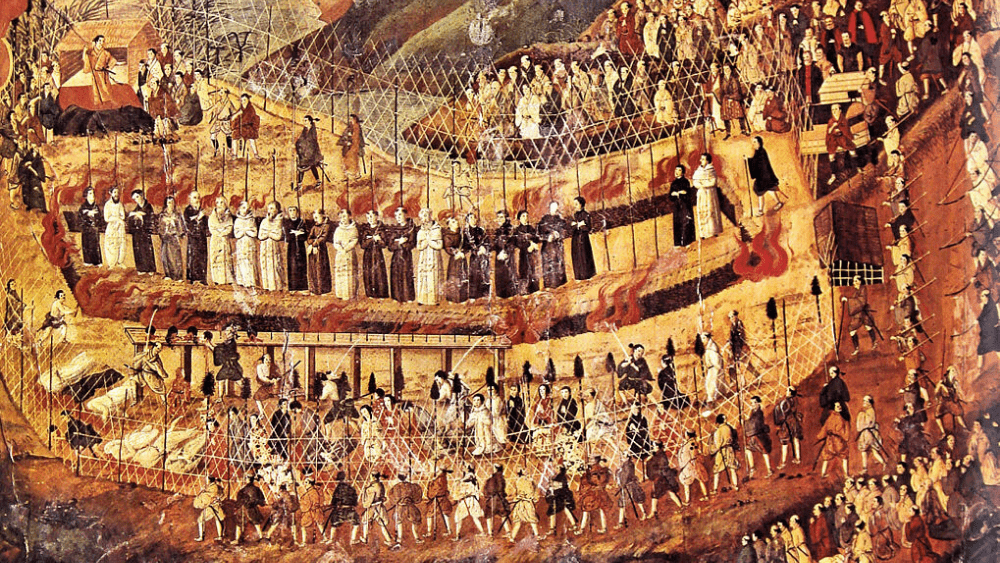Pope Francis has paid homage to tens of thousands of Japanese Christians who were persecuted, forced to keep silent about their faith and martyred, during his visit to Japan on Sunday.
The papal leader visited the Martyrs’ Monument on Nishizaka Hill in Nagasaki, a shrine commemorating 26 martyrs from one of history’s darkest periods for Japanese Christians.
Suspected Christians were forced to trample on holy images … to renounce their Christianity.
The martyrs commemorated at the site were tortured and crucified (in a Japanese style) on crosses outside Nagasaki on 5 February 1597.
Pope Francis told those gathered, “I have come to this monument of the martyrs to pay homage to these holy men and women. But I also come in humility, as one who himself, as a young Jesuit from ‘the ends of the earth’, found powerful inspiration in the story of the early missionaries and the Japanese martyrs.”
“May we never forget their heroic sacrifice. May it not remain as a glorious relic of the past, to be kept and honoured in a museum, but rather as a living memory, an inspiration for the works of the apostolate and a spur to renewed evangelisation in this land,” Pope Francis said.
When Christianity was introduced to Japan by Jesuit missionaries from Portugal around 1550, converts experienced a period of relative favour. The religion took off, as Jesuit missionaries converted feudal lords – some of whom may have been dubiously motivated by increased trade opportunities with Portugal.
At its peak, there were up to 500,000 people in Nagasaki who identified as Christian. Under military leader Oda Nobunaga, Catholic Christian converts were well-treated between 1568 to 1582.
By 1614, Toyotomi Hideyoshi – a great samurai warrior known as Japan’s “great unifier” – banned Jesuits and other foreign missionaries as threats to national unity. The persecution of Christians intensified during the Edo period, up until 1871.
As depicted in Martin Scorsese’s challenging drama Silence (2016), suspected Christians were forced to trample on holy images so as to renounce their Christianity. Those who refused were usually killed. As a result, many Christians went underground, becoming known as kakure kirishitan (“hidden Christians”).
Mitsuhiro Tateishi is a Catholic Christian whose family history traces back to these hidden Christians. He told Vatican Radio that, according to bis father’s testimony, his family was converted during the ministry of Saint Francis Xavier, who first brought Christianity to Japan in 1549.
When Christians began to be persecuted, Tateishi explained “my family chose the way to survive so that they could keep and convey the true faith to their descendants.” For the following 250 years, his ancestors hid on Kuroshima Island, faithfully passing on their faith from generation to generation without the guidance of a Christian leader or priest.
“The Christians helped each other and practiced the teachings of Jesus’ love,” said Tateishi.
“Here we see the darkness of death and martyrdom, but also the light of the resurrection.” – Pope Francis
It was only after Japan allowed freedom of religion in 1871 that Catholic missionaries legally returned and discovered the descendants of those who kept the faith in silence.
On Sunday, Pope Francis said the Nagasaki “shrine does more than speak of death; it also speaks of the triumph of life over death”. He noted Pope John Paul II described it as “a true Mount of the Beatitudes, where our hearts can be stirred by the witness of men and women filled with the Holy Spirit and set free from selfishness, complacency and pride. For here the light of the gospel shone forth in the love that triumphed over persecution and the sword.”
“This shrine is above all a monument to Easter, for it proclaims that the last word – despite all evidence to the contrary – belongs not to death but to life. We are not destined for death but for the fullness of life. This was the message the martyrs proclaimed. Yes, here we see the darkness of death and martyrdom, but also the light of the resurrection, as the blood of the martyrs becomes the seed of the new life that Jesus wishes to bestow on us,” Francis declared.
Japan has not had a visit from a papal leader since Pope John Paul II visited in 1981. Francis has made Asia a priority, also visiting Thailand on this trip, along with South Korea in 2014, Sri Lanka and the Philippines in 2015, and Myanmar and Bangladesh in 2017.
Email This Story
Why not send this to a friend?


